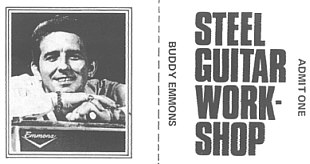|
TEXT FROM COLUMN:
"When working the road, I encounter a great number of musicians, and
a greater number of questions. One of the most frequently asked is
that of single-string technique. In answer to this I have prepared 6
bars of a blues on the C6th tuning. We start in G, with chords, and
end with two bars of single string in C. From there, back to G, and
finish with your own interpretation.
The success of clean notes on an up tempo tune depends on proper muting of
strings after they are picked. I use the thumb and second finger,
muting with the right palm edge and third finger. There are two
occasions for using the palm edge. One, when picking with the thumb,
and the other when going from a lower string to one higher. When
going from a high string down to a lower string always use the third
finger to mute.
Now let's look at the diagram(s). The pedals involved
are 5, 6 and a knee lever marked RKL (it's marked f in the tab),
which on my guitar is positioned for the right knee and pushes to the
left. It lowers the 3rd (c) string one-half tone. If you refer
to the last issue you will find an explanation of pedals 5 and 6. (Pedal
5 raises the first string G to G# - lowers the 5th string G to F# - raises
the 9th string F to F# - and raises the 10th string C to D. Pedal 6
raises the 2nd string E to F - lowers the 6th string F to Eb.)
The numbers on the strings indicate the frets the strings are to be played
on. The pedal numbers are shown below the strings with N.P.
indicating no pedals. (When I did the tab for this I put it into
Buddy's more recent format of putting the pedal change indicator after the
string being played.)
When you are acquainted with this diagram system we will be able to answer
many questions you might have in the way of kick-offs, turn-arounds, and
background fills. Work on the right hand slowly at first; and as you
learn to mute, your speed will follow unconsciously."
|



